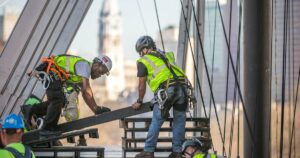Beneath Tesla’s forward-thinking and world-saving rhetoric, Richard Ortiz found broken promises, brutal working conditions, and exploitative management practices. So he began organizing with his co-workers to help form a union. After harassing him for nearly a year, Tesla illegally fired Ortiz in October 2017. The National Labor Relations Board ordered Tesla to reinstate Ortiz and give him back pay, but the company continues to refuse to comply with the order and to mislead the public about conditions for their workers.
Richard Ortiz was between jobs when his son suggested he try working at the Tesla factory in Fremont, California. Ortiz had worked at the same factory for almost 30 years when it was unionized and operated by General Motors and Toyota’s New United Motor Manufacturing (NUMMI). When the facility closed in 2009, Ortiz took whatever work he could find, bouncing between auto-body shops. Under Tesla, the factory has expanded to ten million square feet, employing more than 10,000 workers. “When I got in there, I liked it,” Ortiz told More Perfect Union. “It was different. It was a building I was used to, but it was clean.”
It did not take long for Ortiz to notice more negative differences between working for Tesla and his previous job. The first major one was pay: “When I was doing the same job [before], we were making a lot more money between $30 and $35 an hour. And Tesla, we’re getting $20 an hour,” Ortiz explained. “I was able to start planning my retirement the first week. With Tesla, not so much. You weren’t sure if it’d be there next week, next month.” Ortiz found little transparency around transfers and promotions, with the management constantly changing the criteria and standards for how to advance at the company.
In addition to worse pay, Ortiz observed appalling working conditions at Tesla. Employees were expected to work twelve hours a day, six days a week, with no flexibility. “I’ve seen guys that were so afraid of missing they were throwing up in buckets cause they were sick,” Ortiz said. The company would have workers do two jobs at once, “running back and forth between the two of them” and increasing the risk of injury and burnout. When Ortiz would raise safety issues to management, “they’d look concerned. They’d take a note and that’d be the end of it,” he said.
Ortiz was not the only one to notice Tesla’s exploitation of workers. A 2017 report found that the injury rate at the company’s factories was 31 percent higher than the industry standard—and that the rate of serious injuries at Tesla’s Fremont plant was almost double the industry standard for 2015. These figures do not even account for all of the injuries in the plants; Tesla mislabels injuries as “personal medical” cases and injured workers are routinely sent back to the production line to work through their pain so they are not counted on legally mandated safety reports.
Tesla’s disregard for worker well-being goes all the way to the top. Chief Executive Elon Musk dislikes hanging too many signs, which are critical workplace safety reminders; the warning beeps forklifts make when backing up; “anything yellow,” despite the fact that using yellow is a best practice for high visibility caution signs and tape; or requiring safety shoes in Tesla factories. Musk’s aggressive growth targets contribute to a culture of cutting corners and minimizing employee concerns. When California officials asked the company to address safety violations at the factories, executives gave misleading statements. And managers’ fear of crossing Musk makes them reluctant to implement safety measures despite workers being sliced by machinery, crushed by forklifts, burned in electrical explosions, and sprayed with molten metal.
By the time Ortiz joined the Fremont factory, the United Auto Workers had begun organizing the shop. After his manager saw Ortiz handing out union flyers outside the plant, the company began retaliating against him, assigning him to work in an isolated corner of the facility and repeatedly calling him to the management office to interrogate him. “I felt like my rights were being violated,” he said. “They were coming at me under false pretenses to get the information they wanted to bust the union.” By the time Ortiz was fired in 2017, he had many employees wearing union shirts and committed to a walkout if necessary.
The United Auto Workers appealed Ortiz’s illegal firing to the National Labor Relations Board, alleging unlawful retaliation for union activity. In March of this year the Board ruled in Ortiz’s favor, ordering Tesla to reinstate Ortiz, give him back pay for the period since he was fired, and post a notice in the factory committing not to violate labor law in the future. The Board also ruled that Musk had unlawfully threatened workers with the loss of stock options if they unionized and ordered him to delete anti-union tweets.
It’s worth noting that penalties for employers who engage in union-busting activities are paltry under current labor law. Legislation like the PRO Act could increase consequences for executives like Musk who use the bully pulpit to shrug off concerns about worker safety and rights in the name of “innovation.” And despite the fact that deleting a tweet that discourages workers from organizing and posting a notice admitting the company’s labor violations could hardly be described as burdensome, Tesla has appealed the NLRB’s ruling twice.
“I’m still here because, you know, Elon keeps appealing,” explained Ortiz. “It’s going to only get worse for him, but he don’t care because I was too strong of an organizer. And he feels like I’m going to go in there and do it again. And I will. That’s exactly what I want to do.”


